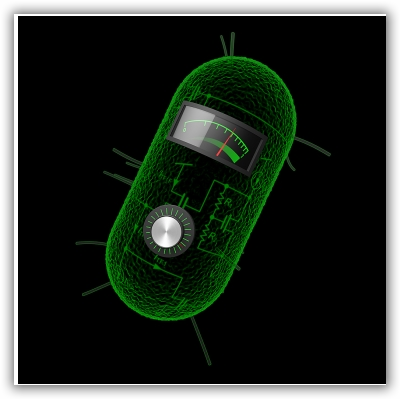aNewDomain.net — MIT this week published a paper explaining a recent advance where researchers have managed to turn bacterial cells into circuits capable of calculating logarithms, square roots and perform other simple math functions. According to MIT, the researchers simply engineered genes in unique ways to do it.
How does it work?
According to Rahul Sarpeshkar and Timothy Lu, two of the authors of the paper that described the biological circuits in the May 15 online edition of the science journal Nature, the bacterial circuits use analog methods and exploit the biochemical functions the cells naturally perform.
Sarpeshkar, who is an MIT professor of electrical engineering and computer science and heads MIT’s Analog Circuits and Biological Systems group, explained that analog computation at the cellular level could conceivably be combined with traditional digital circuits.
Lu, who is also an EE and computer science professor at MIT and teaches bio engineering added:
You (are able to) do a lot of upfront sensing with the analog circuits because they’re very rich and a relatively small amount of parts can give you a lot of complexity, and have that output go into a circuit that makes a decision — is this true or not?”
MIT spokesmen point out that this is just the latest development in an ongoing effort. Sarpeshkar already identified the fact that there were thermodynamic similarities between regular analog transistor circuits and the natural biochemical reactions that occur within cells. Back in 2011, he showed how those similarities are useful in action. He actually modeled biological interactions using eight transistors with DNA and the protein DNA codes for them.
The latest development described by MIT this week in Nature is exactly the opposite. Lu, Sarpeshkar and other colleagues now are mapping analog electronic circuits directly onto genetically engineered cells.
According to MIT:
Sarpeshkar has long advocated analog computing as a more efficient alternative to digital computation at the moderate precision of computation seen in biology. These analog circuits are efficient because they can take in a continuous range of inputs, and they exploit the natural continuous computing functions that are already present in cells. In the case of cells, that continuous input might be the amount of glucose present. In transistors, it’s a range of continuous input currents or voltages … digital circuits …, represent every value as (either) zero or one, ignoring the range of possibilities in between … This (is potentially) useful for creating circuits that perform logic functions such as AND, NOT and OR inside cells, which many synthetic biologists have done. These circuits can reveal whether or not a threshold level of a certain molecule is present, but not the exact amount of it.”
Consider, too, that digital circuits require many more parts than analog circuits do. So creating analog computers from cells is easier and takes less energy.
The field we’re talking about here is called analog synthetic biology. And though it sounds like science fiction, it is anything but.
According to MIT, creating a cell capable of adding or multiplying via analog methods is just a matter of combining two biological “circuits” — in this case a sugar (arabinose) which activates the gene responsible for creating a green flourescent protein, or GFP. The second molecule similarly activates a gene that also turns on a gene that produces GFP. So addition and multiplication is possible simply by adding the total amount of GFP.
Subtracting and dividing works similarly. Instead of activating genes to create GFP they swap them off with blocking repressor molecules that stop production of GFP.
Says Sarpeshkar:
Analog computation is very efficient … to create digital circuits at a comparable level of precision would take many more genetic parts.”
What’s next? The researchers say they now are set upon creating analog computation living cells not from bacteria, but from mammalian cells. And they are continuously building a growing library of genetic parts they believe will be usable in biological — or cell-based — circuitry of the future.
Says Sarpeshkar:
We have just scratched the surface of what sophisticated analog feedback circuits can do in living cells”
Definitely check out the research paper. You’ll see we’re at the beginning of a revolution in analog synthetic biology, and the implications are staggering in all kinds of use cases, from medical to computational.
Gina Smith is the New York Times best-selling author of Apple co-founder Steve Wozniak’s memoir, iWOZ: How I Invented the Personal Computer and Had Fun Doing It. (W.W. Norton, 2005/2007/2012). With John C. Dvorak and Jerry Pournelle, she is editorial director at aNewDomain.net. Email her at gina@aNewDomain.net, check out her Google + stream here or follow her @ginasmith888.













